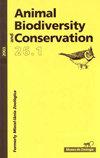生态形态学的差异预测了古巴洞穴蝙蝠的共存吗?
IF 1
4区 环境科学与生态学
Q3 BIODIVERSITY CONSERVATION
引用次数: 0
摘要
生态形态的差异是否预示着洞穴蝙蝠在古巴的共存?识别影响物种共存的机制是理解生物多样性模式和过程的基础。在此,我们旨在评估古巴洞穴蝙蝠共存和形态之间的关系,以及形态和饮食方面的差异。我们收集了来自108个地点的物种列表,其中至少有3种共居物种。至少三个地区的14种蝙蝠被包括在内。在文献资料的基础上,我们还得到了五种形态变量的平均值和日粮的基本组成。我们根据每对物种之间出现的棋盘单位的平均数量,使用EcoSim v7.72计算共存模式。我们使用神经回归网络评估了形态变量和饮食对物种之间共存程度的预测能力。接受最佳神经网络(相关系数为0.87,训练误差< 0.006)。预测误差为共存指数值的13.5%(±1.1)。我们的研究结果表明,古巴洞穴蝙蝠组合的组成不是偶然的。相反,我们发现功能最不同的物种倾向于共存。这一发现与竞争关系对古巴洞穴蝙蝠种类构成的影响是一致的。本文章由计算机程序翻译,如有差异,请以英文原文为准。
¿Las diferencias ecomorfológicas predicen la coexistencia de murciélagos cavernícolas en Cuba?
Do ecomorphological differences predict the co–existence of cave bats in Cuba?
Identifying mechanisms that influence the coexistence of species is primordial to understanding patterns and processes in biodiversity. Here we aimed to assess the association between coexistence and morphology of cave bats in Cuba and differences in morphologic and dietary aspects. We assembled lists of species from 108 localities with at least three co–inhabiting species. Fourteen species of bats in at least three localities were included. Based on the literature we also obtained the mean values of five morphological variables and the basic composition of diet. We calculated coexistence patterns using EcoSim v7.72 based on the average number of checkerboard units that appeared between each pair of species. We evaluated the predictive capacity of the morphological variables and diet over the degree of coexistence between species using a neural regression network. The best neural network was accepted (correlation of 0.87, training error < 0.006). The prediction error was 13.5 % (± 1.1) of the value of the coexistence index. Our findings indicate that the composition of cave bat assemblages in Cuba has not come about by chance. Rather, we found that the most functionally different species tended to coexist. This finding is consistent with the effect of competitive relationships driving the composition of species of cave bats in Cuba.
求助全文
通过发布文献求助,成功后即可免费获取论文全文。
去求助
来源期刊

Animal Biodiversity and Conservation
农林科学-动物学
CiteScore
2.00
自引率
0.00%
发文量
21
审稿时长
>12 weeks
期刊介绍:
Animal Biodiversity and Conservation (antes Miscel·lània Zoològica) es una revista interdisciplinar, publicada desde 1958 por el Museu de Ciències Naturals de Barcelona. Incluye artículos de investigación empírica y teórica en todas las áreas de la zoología (sistemática, taxonomía, morfología, biogeografía, ecología, etología, fisiología y genética) procedentes de todas las regiones del mundo. La revista presta especial interés a los estudios que planteen un problema nuevo o introduzcan un tema nuevo, con hipòtesis y prediccions claras, y a los trabajos que de una manera u otra tengan relevancia en la biología de la conservación. No se publicaran artículos puramente descriptivos, o artículos faunísticos o corológicos en los que se describa la distribución en el espacio o en el tiempo de los organismes zoológicos.
 求助内容:
求助内容: 应助结果提醒方式:
应助结果提醒方式:


